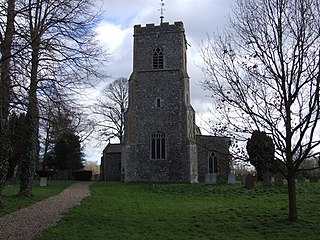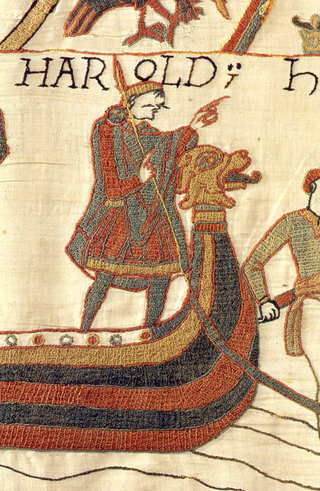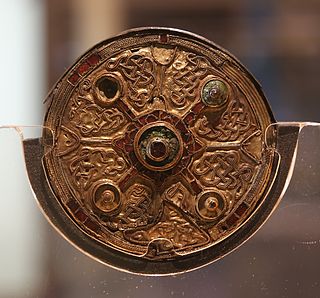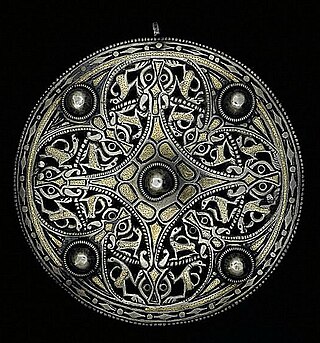
Sutton Hoo is the site of two Anglo-Saxon cemeteries dating from the 6th to 7th centuries near Woodbridge, Suffolk, England. Archaeologists have been excavating the area since 1938, when an undisturbed ship burial containing a wealth of Anglo-Saxon artifacts was discovered. The site is important in establishing the history of the Anglo-Saxon kingdom of East Anglia as well as illuminating the Anglo-Saxons during a period which lacks historical documentation.
The Prittlewell royal Anglo-Saxon burial or Prittlewell princely burial is a high-status Anglo-Saxon burial mound which was excavated at Prittlewell, north of Southend-on-Sea, in the English county of Essex.

Winfarthing is a village and civil parish in the English county of Norfolk. It is located 6 km (4 mi) north of the town of Diss, 20 km (12 mi) east of the town of Thetford, and 30 km (19 mi) south of the city of Norwich. The gold and garnet Anglo Saxon Winfarthing pendant was found nearby in 2014.

Anglo-Saxon dress refers to the clothing and accessories worn by the Anglo-Saxons from the middle of the fifth century to the eleventh century. Archaeological finds in Anglo-Saxon cemeteries have provided the best source of information on Anglo-Saxon costume. It is possible to reconstruct Anglo-Saxon dress using archaeological evidence combined with Anglo-Saxon and European art, writing and literature of the period. Archaeological finds have both supported and contradicted the characteristic Anglo-Saxon costume as illustrated and described by these contemporary sources.

The Staffordshire Hoard is the largest hoard of Anglo-Saxon gold and silver metalwork yet found. It consists of almost 4,600 items and metal fragments, amounting to a total of 5.1 kg (11 lb) of gold, 1.4 kg (3 lb) of silver and some 3,500 pieces of garnet cloisonné jewellery. It is described by the historian Cat Jarman as "possibly the finest collection of early medieval artefacts ever discovered".

The Canterbury-St Martin's hoard is a coin-hoard dating from the 6th century, found in the 19th century at Canterbury, Kent. The group, in the World Museum, Liverpool, consists of eight items, including three gold coins mounted with suspension loops for use as pendants. One of these is the Liudhard medalet, the earliest surviving Anglo-Saxon coin. Another coin is in the Bibliotheque Nationale.

Bryan Faussett was an English antiquary. Faussett formed a collection that was rich in Anglo-Saxon objects of personal adornment, such as pendants, brooches, beads and buckles. He discovered the Kingston Brooch, the largest known Anglo-Saxon composite brooch. At the time of his death he had the world's largest collection of Anglo-Saxon items.

The Trumpington bed burial is an early Anglo-Saxon burial of a young woman, dating to the mid-7th century, that was excavated in Trumpington, Cambridgeshire, England in 2011. The burial is significant both as an example of a bed burial, and because of the ornate gold pectoral cross inlaid with garnets that was found in the grave.

The Street House Anglo-Saxon cemetery is an Anglo-Saxon burial ground, dating to the second half of the 7th century AD, that was discovered at Street House Farm near Loftus, in the unitary authority of Redcar and Cleveland, England. Monuments dating back as far as 3300 BC are located in the vicinity of the cemetery, which was discovered after aerial photography revealed the existence of an Iron Age rectangular enclosure. The excavations, carried out between 2005 and 2007, revealed over a hundred graves dating from the 7th century AD and the remains of several buildings. An array of jewellery and other artefacts was found, including the jewels once worn by a young high-status Anglo-Saxon woman who had been buried on a bed and covered by an earth mound.

The Harford Farm Brooch is a 7th-century Anglo-Saxon disk brooch. The brooch was originally made in Kent and was found along with a number of other artifacts during an excavation of an Anglo-Saxon cemetery at Harford Farm in Norfolk. The brooch measures 72 millimetres (2.8 in) across and was found in grave 11. The front of the brooch is gold decorated with glass and garnets while the backplate is silver. On the back of the brooch there is a runic inscription reading "ᛚᚢᛞᚪ:ᚷᛁᛒᛟᛏᚫᛋᛁᚷᛁᛚᚫ" (luda:gibœtæsigilæ), which Norfolk Museums & Archaeology Service translates as “Luda repaired the brooch”; however “may Luda make amends by means of the brooch” has been offered as a translation by Alfred Bammesberger in the journal Neophilologus. In addition to the runes, the back of the brooch also has a scratched zoomorphic decoration.

Trewhiddle style is a distinctive style in Anglo-Saxon art that takes its name from the Trewhiddle Hoard, discovered in Trewhiddle, Cornwall in 1770. Trewhiddle ornamentation includes the use of silver, niello inlay, and zoomorphic, plant and geometric designs, often interlaced and intricately carved into small panels. It was primarily used to decorate metalwork. During the late Anglo-Saxon era, silver was the precious metal most commonly used to create Trewhiddle style jewellery and to decorate weapons. Famous examples include the Pentney Hoard, the Abingdon sword, the Fuller brooch, and the Strickland brooch.

The Shorwell helmet is an Anglo-Saxon helmet from the early to mid-sixth century AD found near Shorwell on the Isle of Wight in southern England. It was one of the grave goods of a high-status Anglo-Saxon warrior, and was found with other objects such as a pattern-welded sword and hanging bowl. One of only six known Anglo-Saxon helmets, alongside those found at Benty Grange (1848), Sutton Hoo (1939), Coppergate (1982), Wollaston (1997), and Staffordshire (2009), it is the sole example to derive from the continental Frankish style rather than the contemporaneous Northern "crested helmets" used in England and Scandinavia.
The year 2014 in archaeology involved some significant events.

A disc fibula or disc brooch is a type of fibula, that is, a brooch, clip or pin used to fasten clothing that has a disc-shaped, often richly decorated plate or disc covering the fastener. The terms are mostly used in relation to the Middle Ages of Europe, especially the Early Middle Ages. They were the most common style of Anglo-Saxon brooches.

The Kingston Brooch is the largest known Anglo-Saxon composite brooch, and is considered by scholars to be an outstanding example of the composite disc brooch style. Over time, the Kingston brooch has become widely recognized for its charm, inherent value and detailed workmanship. The brooch, created in the seventh century, is now in the World Museum Liverpool in Liverpool, England.

Anglo-Saxon brooches are a large group of decorative brooches found in England from the fifth to the eleventh centuries. In the early Anglo-Saxon era, there were two main categories of brooch: the long (bow) brooch and the circular (disc) brooch. The long brooch category includes cruciform, square-headed, radiate-headed, and small-long brooch brooches. The long brooches went out of fashion by the end of the sixth century.

The Pentney Hoard is an Anglo-Saxon jewellery hoard, discovered by a gravedigger in a Pentney, Norfolk churchyard in 1978. The treasure consists of six silver openwork disc brooches, five made entirely of silver and one composed of silver and copper alloy. The brooches are decorated in the 9th century Trewhiddle style. The hoard is now in the British Museum.
The Beeston Tor Hoard is an Anglo-Saxon jewellery and coin hoard discovered in 1924 at Beeston Tor in Staffordshire. The hoard consists of forty-nine coins, two silver brooches with Trewhiddle style decoration, three finger rings, and miscellaneous fragments. The coins date the burial of the hoard to approximately 875 AD.
Overstone Anglo-Saxon cemetery is an Anglo-Saxon place of burial discovered at the Overton Leys housing development site near the village of Overstone, Northamptonshire. The burial site was found during an archaeological investigation in 2019, prior to the start of the new project. It is the biggest Anglo-Saxon cemetery ever found in Northamptonshire. The 15 hectare site was excavated in 2019 by the Museum of London Archaeology over a 12 month period. Uncovered during the excavation were 154 individual graves and 3000 artefacts. Included in the individual burials were many grave goods, consisting primarily of jewellery and weapons. Household objects, personal items and a few textile fragments were also found. The several pieces of jewellery included 150 brooches, 15 rings, 75 bracelets, 15 chatelains and over 2000 beads. The weapons found were: 25 spears, 40 knives and 15 shield bosses.














